PANI 功能化 MXene/SnOx 多孔异质结构作为检测食品中木犀草素的新型电化学传感平台
IF 4.9
2区 化学
Q1 CHEMISTRY, ANALYTICAL
引用次数: 0
摘要
叶黄素是一种天然类黄酮化合物,广泛存在于水果、蔬菜和草药中。合理摄入对治疗咳嗽、炎症、心血管疾病和其他疾病有益。本研究首先通过水热法制备了 MXene/SnOx 复合材料,然后通过原位化学聚合进行功能化,形成了具有三维异质导电结构的 MXene/SnOx/PANI 复合材料。复合材料通过 SEM、XRD 和 XPS 进行了表征。与 MXene 相比,添加 SnOx 可使复合材料具有更大的比表面积和更多暴露的活性位点。此外,PANI 在 MXene/SnOx 表面的原位聚合和功能化促进了复合结构中电子传导路径数量的增加,并有效加速了电极界面上的电荷转移。三维异质导电结构的形成促进了传感界面上 Lut 的电化学氧化还原过程。基于这些优异的特性,MXene/SnOx/PANI 修饰电极在路得检测方面具有出色的性能,其检测范围为 0.2-6.5 μM,检测限为 0.12 μM。此外,它还具有良好的重复性、稳定性和抗干扰能力,可用于准确测定实际紫苏和菊花样品中的泸脱含量,其结果与紫外可见光谱法一致。本文章由计算机程序翻译,如有差异,请以英文原文为准。

PANI-functionalized MXene/SnOx porous heterostructures as a novel electrochemical sensing platform for detecting luteolin in food
Luteolin is a natural flavonoid compound widely found in fruits, vegetables, and herbs. Reasonable intake is beneficial for the treatment of cough, inflammation, cardiovascular disease and other diseases. In this study, MXene/SnOx composites were first prepared hydrothermally and then functionalized by in situ chemical polymerization to form MXene/ SnOx/PANI composites with three-dimensional heterogeneous conductive structures. The composites were characterized via SEM, XRD, and XPS. Compared with MXene, the addition of SnOx results in composites with a larger specific surface area and more exposed active sites. In addition, the in situ polymerization and functionalization of PANI on the surface of MXene/SnOx promotes an increase in the number of electronic conduction paths in the composite structure and effectively accelerates charge transfer at the electrode interface. The formation of a three-dimensional heterogeneous conductive structure promotes the electrochemical redox process of Lut at the sensing interface. On the basis of these excellent properties, the MXene/SnOx/PANI modified electrode has outstanding performance in Lut detection, with a detection range of 0.2–6.5 μM and a detection limit of 0.12 μM. In addition, it has excellent repeatability, stability, and anti-interference ability and can be used to accurately determine the Lut content in real Perilla and Chrysanthemum samples, and the results are consistent with those of UV–Vis.
求助全文
通过发布文献求助,成功后即可免费获取论文全文。
去求助
来源期刊

Microchemical Journal
化学-分析化学
CiteScore
8.70
自引率
8.30%
发文量
1131
审稿时长
1.9 months
期刊介绍:
The Microchemical Journal is a peer reviewed journal devoted to all aspects and phases of analytical chemistry and chemical analysis. The Microchemical Journal publishes articles which are at the forefront of modern analytical chemistry and cover innovations in the techniques to the finest possible limits. This includes fundamental aspects, instrumentation, new developments, innovative and novel methods and applications including environmental and clinical field.
Traditional classical analytical methods such as spectrophotometry and titrimetry as well as established instrumentation methods such as flame and graphite furnace atomic absorption spectrometry, gas chromatography, and modified glassy or carbon electrode electrochemical methods will be considered, provided they show significant improvements and novelty compared to the established methods.
 求助内容:
求助内容: 应助结果提醒方式:
应助结果提醒方式:


